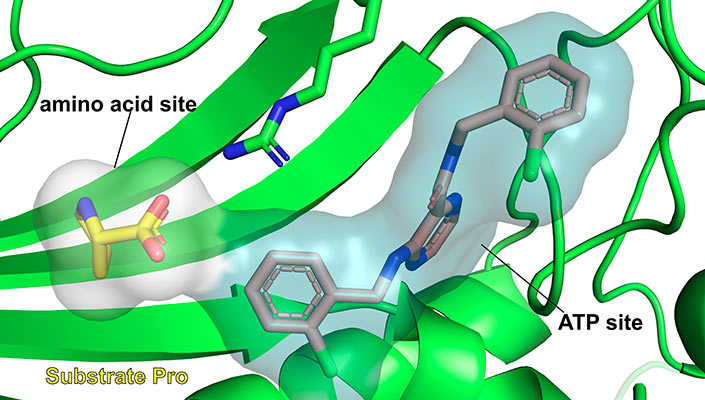The use of previously prepared active compounds in a new indication, so-called drug-repurposing, is one of the modern methods of drug discovery. In the past, our working group Design and Development of New Antimicrobial Agents has prepared a series of 3-aminopyrazine-2-carboxamide derivatives and tested them as potential antibacterial and antimycobacterial compounds. However, we observed only low in vitro activity. Later in the literature, we came across a description of human prolyl-tRNA synthetase (hPRS) inhibitors that were structurally similar to our compounds. As a part of the international collaboration with KU Leuven (Catholic University of Leuven) in the CELSA project, we were able to crystallize our substances with hPRS, confirming their ability to compete for a binding site with ATP, a cofactor for this enzyme. Binding was also confirmed by the TSA (Thermal Shift Assay). The results were published in the International Journal of Molecular Sciences (IF2020 = 5.923 (Q1Q2), doi: 10.3390/ijms22157793). The crystallographic structures of the complexes were published in the Protein Data Bank database.

The most active compound (grey) in the active site of human prolyl-tRNA synthetase
The results of this project are groundbreaking for our group, because for the first time we had the opportunity to study the interactions of our compounds with their receptor at the molecular level. The work also opens a new direction of our research - inhibitors of hPRS (and aminoacyl-tRNA synthetases in general) have potential in the treatment of cancer and autoimmune diseases.
Take-home message: Let's not leave our supposedly uninteresting compounds lying in a drawer - they can find their application in other directions of research.
The study was supported by CELSA grant‚ Structure-based design of new antitubercular medicines’ (Martin Doležal) and by the Ministry of Health of the Czech Republic grant nr. NU21-05-00482 (Jan Zitko).
Text: doc. PharmDr. Jan Zitko, Ph.D.
Figures: Courtesy of the group Design and Development of New Antimicrobial Agents